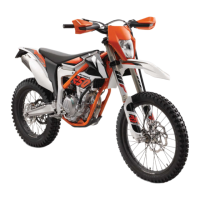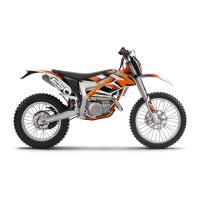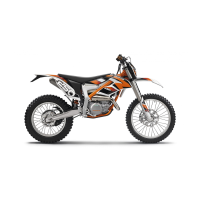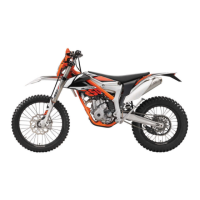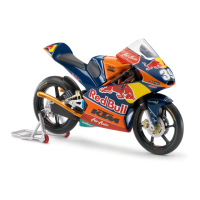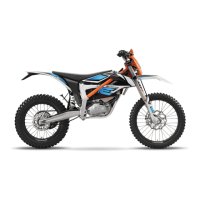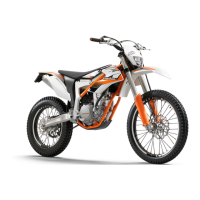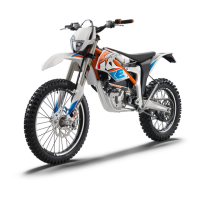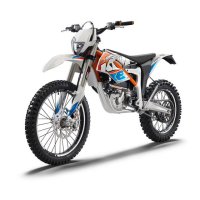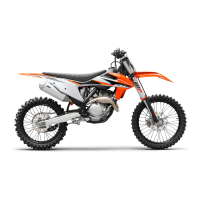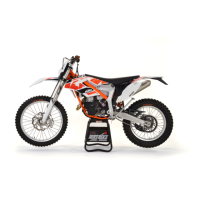
Do you have a question about the KTM Freeride 250 R and is the answer not in the manual?
| Displacement | 249 cc |
|---|---|
| Bore x Stroke | 66.4 mm x 72 mm |
| Starter | Electric starter |
| Transmission | 6-speed |
| Weight | 92.5 kg (without fuel) |
| Cooling | Liquid cooled |
| Front Wheel Travel | 250 mm |
| Rear Wheel Travel | 260 mm |
| Engine Type | Single-cylinder, 2-stroke |
| Frame | Central tube frame made of chrome-molybdenum steel |
| Front Suspension | WP-USD Ø 43 mm |
| Rear Suspension | WP-PDS shock absorber |
| Front Brake | Disc brake |
| Rear Brake | Disc brake |
| Fuel System | Carburetor |
| Front Suspension Alternative | WP Xplor 43 |
| Fuel Tank Capacity Alternative | 7.5 liters |
| Seat Height Alternative | 910 mm |
Explains the meaning of specific symbols used throughout the manual.
Describes typographical formats used in the document for clarity.
Defines the intended use of KTM sport motorcycles for offroad riding.
Provides essential safety instructions for operating the vehicle safely.
Explains safety warnings and their associated risk levels.
Details safe practices, including influence of alcohol, exhaust gases, and hot components.
Emphasizes the importance of wearing proper protective clothing.
Details requirements for maintaining warranty claims and voiding conditions.
Highlights the importance of timely service for optimal operation and longevity.
Illustrates and labels key components visible from the front left.
Illustrates and labels key components visible from the rear right.
Shows the location of the chassis number stamping on the steering head.
Shows the location of the engine number stamping on the engine.
Describes clutch lever, throttle grip, light switch, and horn button.
Details electric starter, emergency OFF switch, and indicator lamps.
Explains filler cap, fuel tap, choke, and steering lock operation.
Details speedometer overview, activation, and possible display messages.
Guides on setting units, clock, and service interval displays.
Explains viewing and resetting trip distances and average speed.
Provides crucial advice for initial operation and safety precautions.
Guides on engine break-in procedures and performance limits.
Lists pre-ride checks and details the procedure for starting the engine safely.
Guides on gear shifting, riding techniques, and handling unusual noises.
Provides instructions and warnings on proper braking and stopping.
Details safe refueling procedures and fuel specifications.
Outlines periodic maintenance tasks based on operating hours.
Lists additional service tasks with their recommended intervals.
Explains how to adjust suspension based on rider weight for optimal handling.
Details adjusting low-speed and high-speed compression damping.
Explains the process for adjusting the rebound damping of the shock absorber.
Covers checking static and riding sag and adjusting spring preload.
Covers checking basic fork settings, compression, and rebound damping.
Provides steps for changing the handlebar position for ergonomics.
Instructions on safely lifting and removing the motorcycle using a stand.
Covers bleeding, dust boots, removing/installing fork legs and protectors.
Details removing/installing triple clamp, checking/adjusting bearing.
Covers removing and installing the rear shock absorber.
Covers removing/installing front fender and seat operations.
Covers housing and filter removal, installation, and cleaning.
Covers removing/installing main silencer and changing yarn filling.
Covers removing and installing the fuel tank.
Covers chain checks, cleaning, tension, sprockets, and guides.
Covers checking the frame and swingarm for damage or deformation.
Covers checking and changing hydraulic clutch fluid.
Covers checking and adjusting free travel of the hand brake lever.
Guides on checking brake disc thickness and for damage.
Covers checking/adding front brake fluid and changing linings.
Covers checking and adjusting the foot brake lever's basic position.
Covers checking/adding rear brake fluid and changing linings.
Covers removing and installing the front wheel.
Covers removing and installing the rear wheel.
Covers inspecting tires for damage and checking air pressure.
Explains how to check spoke tension for wheel integrity.
Covers battery removal, installation, and recharging procedures.
Covers replacing main and individual power consumer fuses.
Covers removing/refitting headlight mask and changing bulbs.
Covers checking and adjusting the headlight beam alignment.
Provides instructions for replacing the speedometer's internal battery.
Guides on checking coolant level and antifreeze protection.
Details procedures for draining and refilling the cooling system.
Guides on checking and adjusting the throttle cable play.
Explains and guides on adjusting carburetor idle speed and mixture.
Guides on cleaning the alternator cover and rotor.
Covers checking, draining, and refilling the gear oil.
Provides instructions and warnings for cleaning the motorcycle.
Outlines precautions for operating and storing the motorcycle in winter.
Details steps for proper long-term storage of the motorcycle.
Guides on getting the motorcycle ready after a period of storage.
Lists possible causes and actions for engine starting issues.
Addresses issues like no idle, poor acceleration, and overheating.
Lists engine design, displacement, frame, and brake system specifications.
Provides torque specifications for engine and chassis components.
Details specifications for suspension settings and tire types.
Specifies recommended brake fluids, coolant, engine oil, and fork oil.
Lists recommended cleaners, greases, and sprays for maintenance.
Explains JASO and SAE standards for motorcycle fluids.
